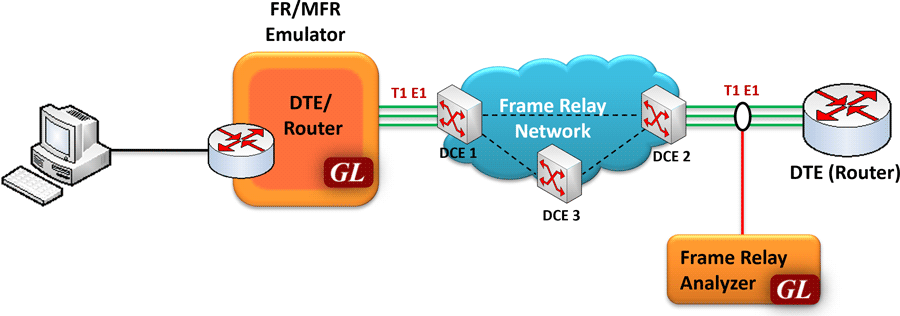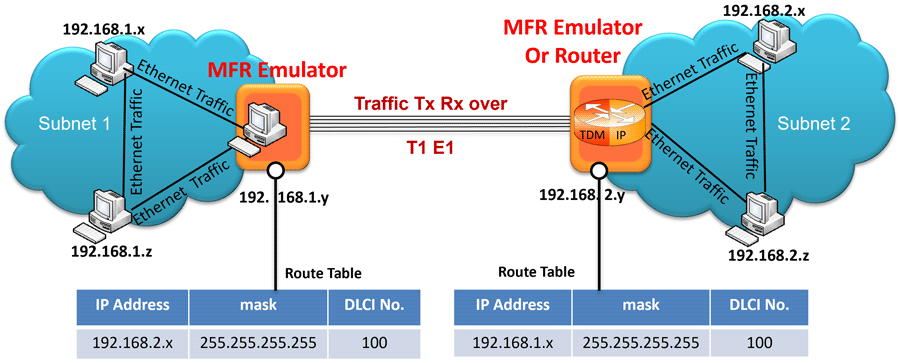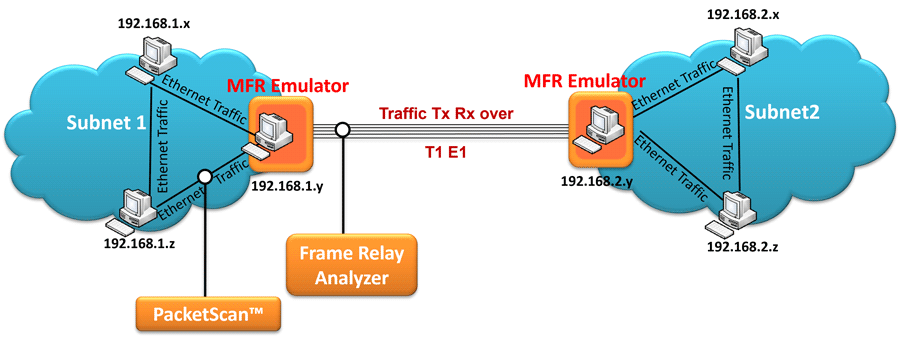Multi-link Frame Relay Emulator
27th, Sep 2019
Welcome to another issue of GL Communications' newsletter providing information on our latest Multi-Link Frame Relay Emulation (MFR) software based on client-server architecture over GL's field proven T1 E1 hardware platforms. The software acts as a Frame Relay (FR)-MFR Data Terminal Equipment (DTE)/Router and generates traffic in compliance with frame relay fragmentation & reassembly models i.e. UNI (DTE-DCE) NNI (DCE peers) & end-to-end fragmentation over multiple virtual circuits.

Overview
Frame Relay (FR) and MFR can be emulated using GL’s Multi-Link Frame Relay Emulator and analyzed using Multi-Link Frame Relay Analysis software. This works with GL’s T1/E1 Analysis hardware platforms (Dual Express (PCIe) T1 E1 Boards, Universal HD T1/E1 Card, USB T1/E1 unit, or tProbe™ T1/E1 unit).
GL’s flexible and versatile Multi-Link Frame Relay Emulator allows traffic generation and verification over FR links and MFR bundles for end to end testing of the frame relay network. The emulator can act as a DTE device and generate test traffic across the frame relay network for checking link quality at various layers of OSI model using Bit Error Rate Testing (BERT). Also, it can act as a DTE router to route or bridge Ethernet traffic over the frame relay links.
In addition, GL's Frame Relay Protocol Analyzer is used to analyze and decode frames conforming to Q.921, Q.922, LAPF, Frame Relay Forum standard - FRF.9 and FRF.12, Multiple Protocol Encapsulation, LCP RFC1661, Q.933 SVC and LMI SNAP, PPP, IP, SMTP, POP3 and so on.
Important features
FR Simulation
Multiple FR links of bandwidths varying from 64Kbps to n*64Kpbs or sub channels can be simulated. Each FR link can be configured with multiple full duplex virtual channels (VC), and each VC is identified by a unique DLCI value. Links can be configured with parameters like fragmentation (adhering to FRF.12 standard), flags between frames, and impairments for simulating real-time network scenarios.
MFR Simulation
Multiple FR links are aggregated to create an MFR bundle with a larger bandwidth pipe. The FR links in a bundle can vary in multiples of 64 Kbps. The emulator creates multiple such MFR bundles. A bundle can be configured with multiple full duplex VC.
Traffic Simulation and Impairments
MFR Emulator supports various types of traffic that enables the user to simulate a FR/MFR DTE or a router.
As a DTE, it can be used to generate a known traffic pattern (user defined hex data, binary file data, BERT) over the virtual circuits. Another MFR Emulator on the other side of the network can verify the received traffic pattern and generate various frame level statistics.
As a router, it can route/bridge the Ethernet traffic across the onboard network interface card and the frame relay network. Also, one can simulate multiple bridged/routed IP traffic streams over frame relay links.
One can intentionally inject errored traffic into the network to simulate real time network scenarios. The user can impair traffic at bit, byte, fragment and frame level to simulate duplicated, inserted, or dropped frames, and can generate frames with CRC and frame errors.
Network Traffic
Real-time traffic can be simulated in network traffic mode, where the MFR Emulator can be configured to bridge or route the IP packets across the Ethernet and frame relay network.
Here, the two networks, subnet1 and subnet2 are connected through T1/E1 lines using MFR Emulator that is configured to work as a router. The MFR Emulator allows the user to setup the routing table by configuring IP Address and Mask. Once configured, the emulator forwards the IP packets which matches the routing criteria over MFR links and responds to all ARP requests originating from IP addresses present in the configured routing table.
Generate Traffic
One can generate IP traffic streams over multiple VCs created within the FR links using MFR-IP-PacketCheck™.
The figure depicts the MFR-IP-PacketCheck™ generating and receiving IP packet streams to a FR router. The FR router is tested to determine if the received packets route to the proper destination. Using GL's IP tools such as
PacketCheck™ and PacketExpert™, one can conduct end-to-end testing of the FR link through the FR router.
For detailed information refer to Multi-link Frame Relay Emulator webpage.


 Back to Newsletter Index Page
Back to Newsletter Index Page